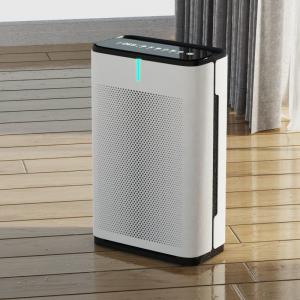

Add to Cart

Whole House Hepa Filter Carbon Filter UV Light WiFi Air Purifier
About Air Purifier History
In 1830, a patent was awarded to Charles Anthony Deane for a device comprising a copper helmet with an attached flexible collar and garment. A long leather hose attached to the rear of the helmet was to be used to supply air, the original concept being that it would be pumped using a double bellows. A short pipe allowed breathed air to escape. The garment was to be constructed from leather or airtight cloth, secured by straps.In the 1860s, John Stenhouse filed two patents applying the absorbent properties of wood charcoal to air purification (patents 19 July 1860 and 21 May 1867), thereby creating the first practical respirator.
In 1871, the physicist John Tyndall wrote about his invention, a fireman's respirator, as a result of a combination of protective features of the Stenhouse's respirator and other breathing devices. This invention was later described in 1875.
In the 1950s, HEPA filters were commercialized as highly efficient air filters, after being put to use in the 1940s in the United States' Manhattan Project to control airborne radioactive contaminants.
The first residential HEPA filter was reportedly sold in 1963 by brothers Manfred and Klaus Hammes in Germany,who created the Incen Air Corporation which was the precursor to the IQAir corporation.
Hepa UV Air Purifier Description
| Product Name | Hepa UV Air Purifier |
| Product Model | y24a |
| Voltage | 220V |
| Power | 120W |
| Sensor | Dust Infrared Sensor |
| Motor | AC Motor |
| Product Size | 390*211*628mm |
| Package Size | 448*270*700mm |
Hepa UV Air Purifier Function
1. Support air purification/plasma/uv/sterilization purification
/PM2.5 particle purification
2. Support filter replacement reminder
3. Support 3 speed adjustment
4. Support PM2.5 digital real-time monitoring display
5. Support intelligent automatic mode
6. Support display mode LED touchscreen display
7. Support sleep mode/silent mode
8. Support child lock function
9. With disinfection product test report/production qualification
and product record,
Applicable to schools/hospitals/nursing homes/banks/offices and
crowded places for sterilization and disinfection
Hepa UV Air Purifier Parameters
1.Rated power: 120W
2.Voltage: 220V/50Hz
3.Wind speed: 3 speed
4.Applicable area: 42m³
5.Particulate clean air quantity: 350m³/h
6.Removal rate of Staphylococcus albus :99.99%
7.Removal rate of natural bacteria in air: 99.54%
UV wavelength: 253.7mm
UV illuminance: 99UW /cm²
8.Color: Ivory/Rose gold/Champagne gold (customizable)
9.Sensor type: Dust infrared sensor
About Hepa UV Air Purifier
If you’re prone to coughing and sneezing indoors, your air quality could be to blame—and that's where the best air purifiers come in. These powerful machines will rid your home of airborne dust mites, pesky dander, and other airborne pollutants.
How do HEPA filters and UV light air purifiers work?
HEPA stands for “high-efficiency particulate arresting.” As the
name suggests, these filters are really good at pulling things out
of the air and holding onto them so that they can’t be
recirculated. The fibers in a HEPA filter are designed to trap
particles as small as .01 micron in diameter — just a tiny fraction
of the width of a human hair.
UV light devices, on the other hand, don’t remove anything.
Instead, they’re designed to kill any viruses, bacteria or mold
spores floating around by exposing them to ultraviolet light.
Studies show that wearing a mask properly and consistently
practicing good social distancing can significantly reduce the
spread of the coronavirus (COVID-19) through droplet transmission.
But concerns about possible aerosol transmission have many people
thinking about air purifiers, too. So, how do the various types of
air cleaners work? Are any of them effective against COVID-19? And
should you get one (or more) for your home?
We spoke with Tim Peglow, our assistant vice president of Patient
Care and Patient Facilities, for guidance. Here’s what he had to
say about air purifiers and COVID-19.
What are the different types of air purifiers?
Most air cleaners fall into two basic categories: filters or
sanitizers. Some combine both types in the same unit.
Filters are designed to improve indoor air quality by physically
removing tiny particles of matter that can be floating around —
such as dust, pollen and pet dander. These are all things that
occur naturally, but can aggravate peoples’ allergies if they
inhale them. The most common type of home filters right now are
HEPA filters.
Sanitizers are designed to kill bacteria, viruses, mold or fungal
spores that can also be floating around. These things occur
naturally, too, but they can make you sick if you’re exposed to
high enough concentrations of them. The most common type of
sanitizers right now are UV light devices.
